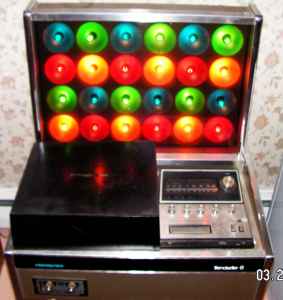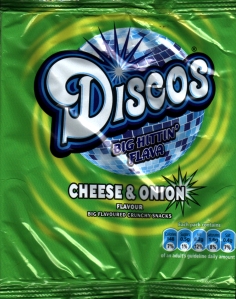Whilst out on one of my regular ambles around Liverpool’s busy city centre, I decided to call into my local branch of Oxfam for a bit of vinyl therapy. As I leafed through the display racks of old 45s, something interesting in the corner of the shop caught my eye… a large cabinet of some description decorated in a highly reflective glittery covering hidden behind a few racks of coats. After pulling aside the racks, I discovered that the mystery cabinet was a 1970s era hi-fi unit, a throwback from the heady days of Disco.
In the 1960s and ‘70s two companies vied for dominance of the lucrative home disco market: ‘Morse Electrophonics’ and ‘Soundesign’. Each company produced various models with different attributes, ranging from built-in light shows, spinning mirror balls, various combinations of hi-fi apparatus and different cabinet styles. They appealed to the affluent 30 something social climbing set that were out to impress, who purchased these units to compliment their home bars and hostess trolleys. In those days, hi-fi was considered furniture – and as such, units were bulky, robust and styled to make them the central feature of the room they inhabited. These groove boxes went beyond conventional hi-fi by literally transforming your living room into a discotheque, where sound and light combined into a hypnotic show against which you could dance the night away, safe in the knowledge that you could be the king of cool in your own living room, no matter how badly your dancing sucked.
This particular unit appears to be a lower end Morse Electrophonic cabinet comprising of a Turntable, 8 track and cassette tape decks and a radio tuner. Because of the size and weight of the cabinet, and the fact that it was wedged into a corner surrounded by clothes racks etc, I was unable to check out its model number or whether the lower portion of the unit had lights mounted behind the mirror panel. Sadly, this unit was not for sale, much to the relief of my wife who momentarily had nightmare visions of yet another hi-fi system competing for space in our overcrowded flat.
The sound to light units on these models were known as ‘Colour Organs’, named after early 18th Century keyboard instruments that controlled various lighting devices which displayed different coloured lights depending on which notes were being played.
The Long and Winding Road to Disco
The concept of associating different colours of light with specific frequencies goes back a very long way. Aristotle (384 -322 BCE) appears to be the first to have speculated that there was a close relationship between colour and sound, an idea that was explored in more detail by Sir Isaac Newton around 1704 CE. Newton paired the dominant 7 colours of the rainbow with the 7 whole tones found in a musical octave, starting with Red at C, Orange at D etc. His ideas were later taken up in a practical manner by Louis Bertrand Castel who constructed an instrument called the ‘Ocular Harpsichord’ around 1730. The instrument consisted of a six foot square frame mounted above a standard harpsichord. The frame contained 60 small boxes, all containing a lit candle. Each box had a little window made out of different coloured glass panes, directly behind which was a small curtain. The harpsichords keys were rigged so that when played, a system of pullies would lift a particular curtain to reveal a flash of corresponding colour. Later improvements added more candles and mirrors to reflect back more light. The instrument was by all accounts smelly, awkward to play and prone to malfunction and fire. However, interest in the instrument was so great that Castel proposed setting up a factory to make them en masse, dreaming of a day when ‘every home in Paris would own one’. Alas, this was not to be, and despite Castel’s big ideas, no physical relic of his Ocular Organ survives today.

Bainbridge Bishop’s Colour Organ – Reproduced from the booklet ‘Harmony of Light’ – Bainbridge Bishop 1893
Next came Bainbridge Bishop, an artist who had more than a passing interest in the relationship between colour and sound. In the early 1890s, Bishop constructed a number of Colour Organs, similar in design to Louis Bertrand Castel’s Ocular Harpsichord, but using electric light instead of candles. In addition, he used a ground glass screen to project on, which produced softer colours that merged into one another producing a more ‘harmonious’ display for the viewer. Bishops Colour Organ was an outstanding success. The use of electric light over candle paved the way for bigger and better Colour Organs to be created for use in large public performances. One notable performance using a Colour Organ (developed by British Painter A. Wallace Rimington), took place in Carnegie Hall, New York in 1915 for a performance of Composer Alexander Scriabin’s symphony ‘Prometheus: A Poem of Fire’. Scriabin wanted to create a work where light and sound could fuse together to produce ‘a transformative effect that would allow the audience to transcend up into a level of spiritual consciousness’. To that end, Scriabin’s music score called for specific colours to be projected for each note played. For this performance Scriabin requested that the audience wear white clothing so that the colours would reflect off their bodies, thereby making them an active part of the performance. Unfortunately, his ideas were too far ahead of their time and the technology of the day failed to capture the effect he desired. That said, the path leading to the union of light and sound in dance form had well and truly been opened.
We now fast forward to France in 1939/40. As the might of the German War machine tore across Europe, occupied nations such as France were forced to fall in line with the whims and philosophies of the New German Master Race. To This end, Adolph Hitler decreed that the performance of American-style Jazz was now prohibited, forcing Jazz clubs to literally go underground. The downsizing of the venues from large halls to small hidden cellars, coupled with the need for secrecy, meant that the clubs could no longer chance having live musicians performing in them. Instead, Jazz records from the US were played, as they were easier to conceal than a four piece combo plus instruments. This was the birth of the ‘Discotheque’ (which translates into ‘Record Library’), a place where people danced solely to recorded music.
After the war, discotheques sprang up all over Europe and the US, and by the early 1960s were considered to be THE place to go to have a good time. With the addition of soul, infectious Latin rhythms and technical advances in amplification and sound production, Disco, as we know it, finally arrived.
On the back of advances in solid state electronics came ‘Sound to Light’ devices which automatically converted audio signals into electrical signals, which were then used to control series’ of lights, making them flash in sequence depending on the input sound’s pitch and rhythm. These ‘sound to light’ units retained the name ‘Colour Organs’ despite no longer having to be bolted to a musical instrument to operate them. Throughout the 1970s, Disco clubs filled their venues with all manner of units, with Colour Organ design becoming more complex and sophisticated, offering more creative and exciting light displays than ever before. In some of the trendiest Disco clubs, even the dance floors got the Colour Organ treatment by having light displays installed underneath toughened translucent polypropylene tiled flooring. Discos became cathedrals of light and sound with no shortage of ‘devotees’ flocking to ‘worship’ on a regular basis. Scriabin’s dream of sound and light transcendence was eventually achieved, although in a way that I am sure Scriabin would not really have approved of.
By the mid ‘70s Disco had become big business and suddenly everybody wanted a slice of the action. Therefore it was only a matter of time before hi-fi manufacturers offered consumers the chance to own their own, albeit scaled down, home disco experience. Que the ‘Soundesign Trendsetters’ and ‘Morse Electrophonic’ hi-fis that became as ubiquitous in 1970s homes as Shag Pile Carpets, Lava Lamps and carafes of cheap Spanish wine.
Eventually the Disco bubble burst in the early 1980s and units like the above became so un-cool that they were unceremoniously dumped and trashed en masse. Today they are incredibly rare, rarer still if in full working order, and can cost anything from £500 – £2000 depending upon the condition. With the passage of time, however, comes forgiveness for crimes of the past, committed against the upstanding pillars of social structure: style and aesthetics, and as such these units are now viewed by some with a rose-tinted nostalgic glow. Maybe they will have their day again eventually, who can say?
For more info and more groovy pics of these amazing hi-fis, check out History Dumpsters excellent blog.
http://historysdumpster.blogspot.co.uk/2012/11/the-soundesign-trendsetter-7.html
Finally, as a form of tribute, here is my own disco revival in the shape of snack food: the wonderfully tasty and chewy Belmont Disco Biscuit (which is currently being re-branded, so catch them while you can) and the totally un-square KP Discos Crisps, both groovy in their own unique way. However, eat too many packets of either and you’ll soon lose your John Travolta/Karen Lynn Gorney physiques. You have been warned.
———-
Many thanks to the manager of the Oxfam shop in Bold Street, Liverpool, for allowing us to ‘wreck’ the back of his shop to take photos.









